Abstract
STUDY OBJECTIVE--To evaluate new national influenza vaccination practices which were started in 1987 under a revised law in Japan. DESIGN--This was a three year, nonrandomised cohort study with information collected by questionnaire between 1989 and 1991. SETTING--Eight primary schools in the city of Yonago, Tottori, Japan. These schools were selected from 23 schools in the city. PARTICIPANTS--Altogether 4251 pupils (1355 boys and 2896 girls) in years 1-4 of the eight primary schools were included in this study, and followed up. Three years later, data for 1619 pupils (768 boys and 851 girls) were obtained and analysed. MAIN RESULTS--The one-winter seasonal incidence rates of influenza-like disease were 13.4%, 29.9%, and 10.3% in 1989, 1990, and 1991 respectively. The incidence rate of influenza-like disease in fully vaccinated pupils was significantly lower than that in unvaccinated pupils in 1990, but not in 1989 or 1991. Stepwise multiple regression analysis showed that the incidence of influenza-like disease had a statistical relationship with the frequency of vaccination and the school year (R2 was 0.0148). Standardised parameters of the frequency of vaccination and the school frequency of vaccination and the school year were -0.089 and -0.080 respectively. CONCLUSIONS--The preventive effects of influenza vaccine are not strong. There must be some unknown factors that affect the incidence of influenza. This vaccine is useful for pupils in the early school years who seem to have less resistance. All pupils should not be inoculated with the vaccine to reduce influenza transmission in the community or school.
Full text
PDF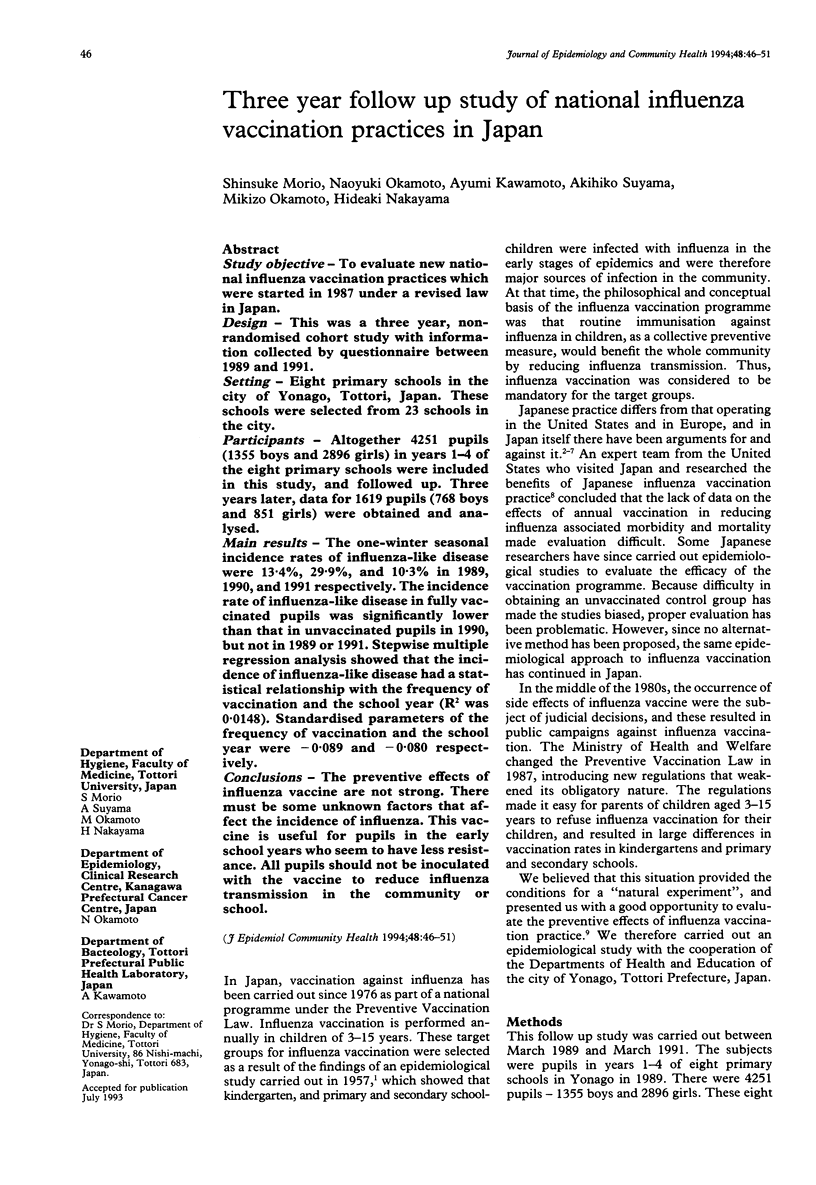
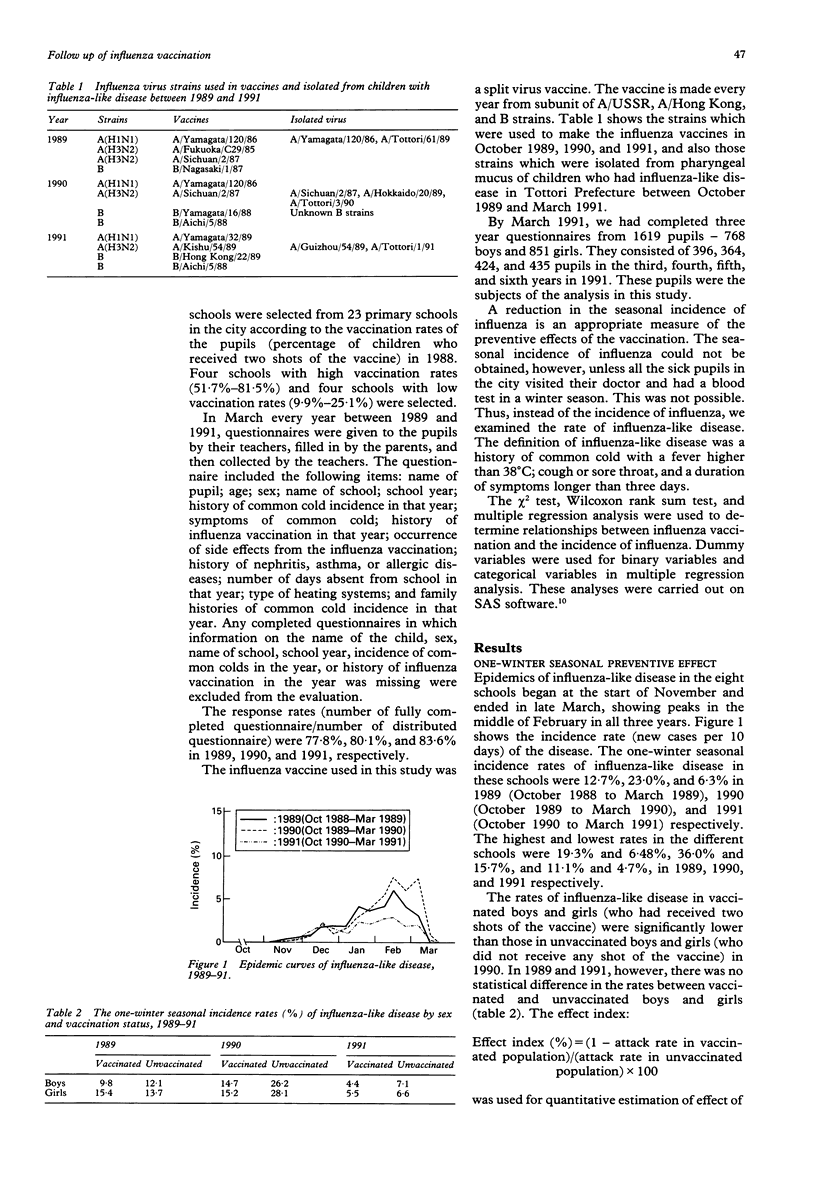
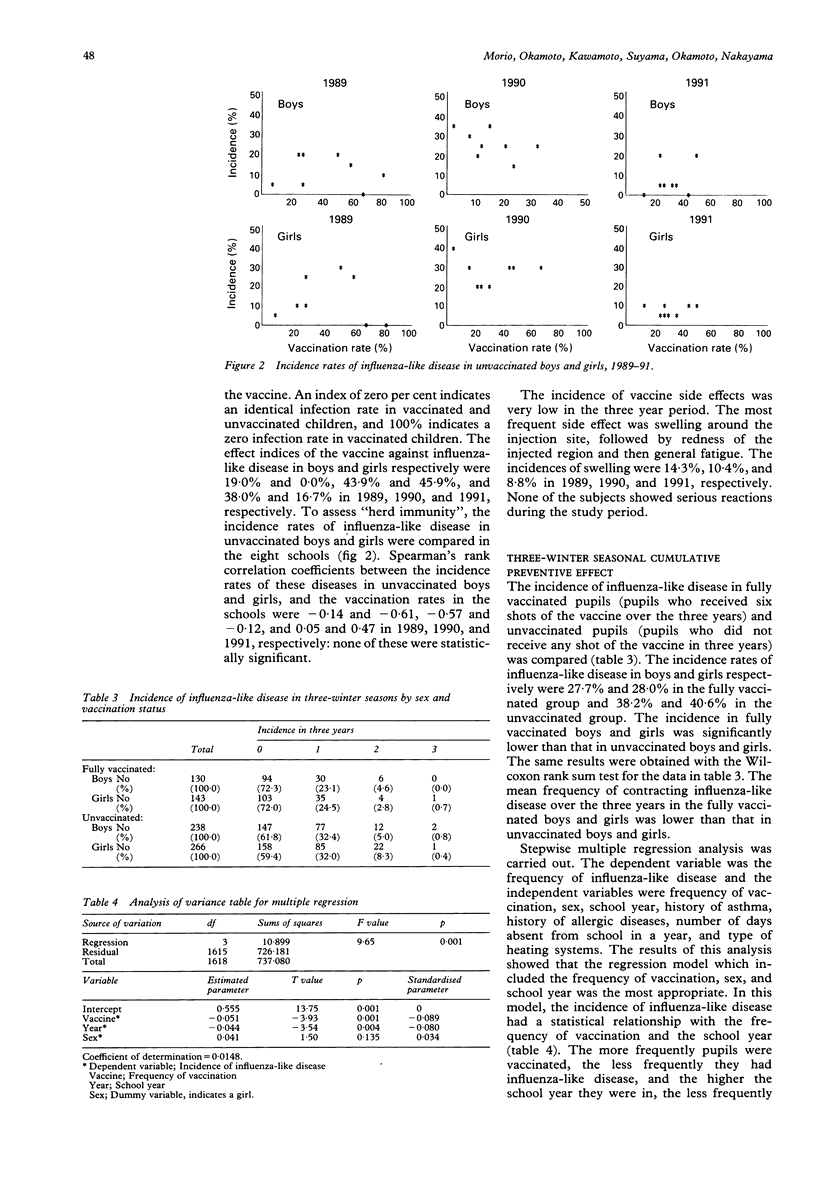
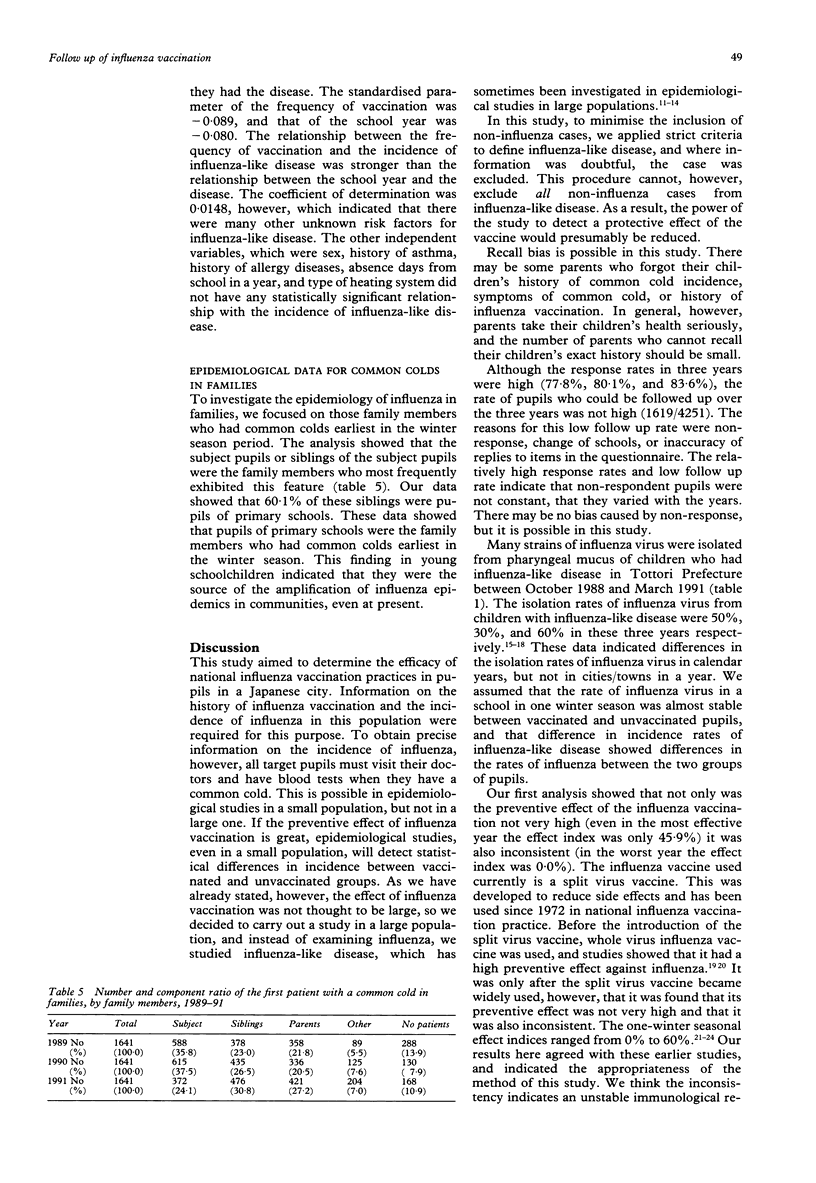
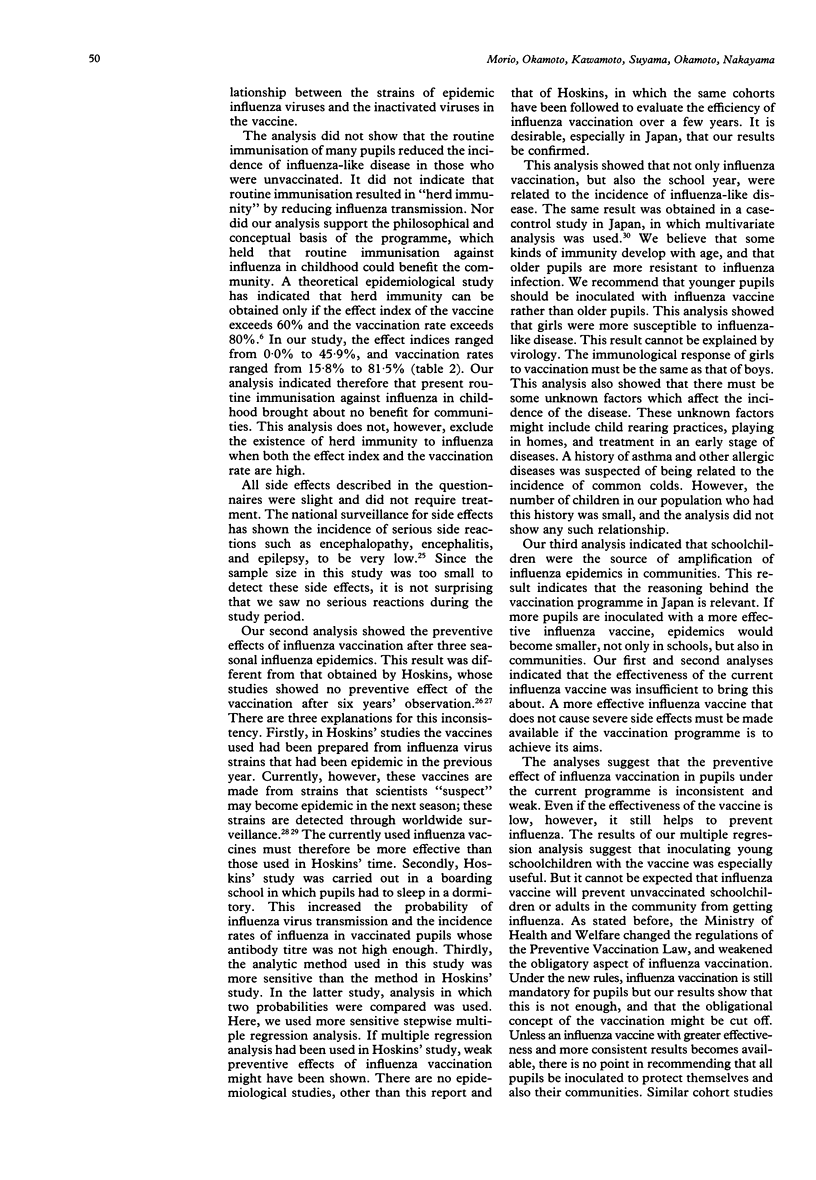
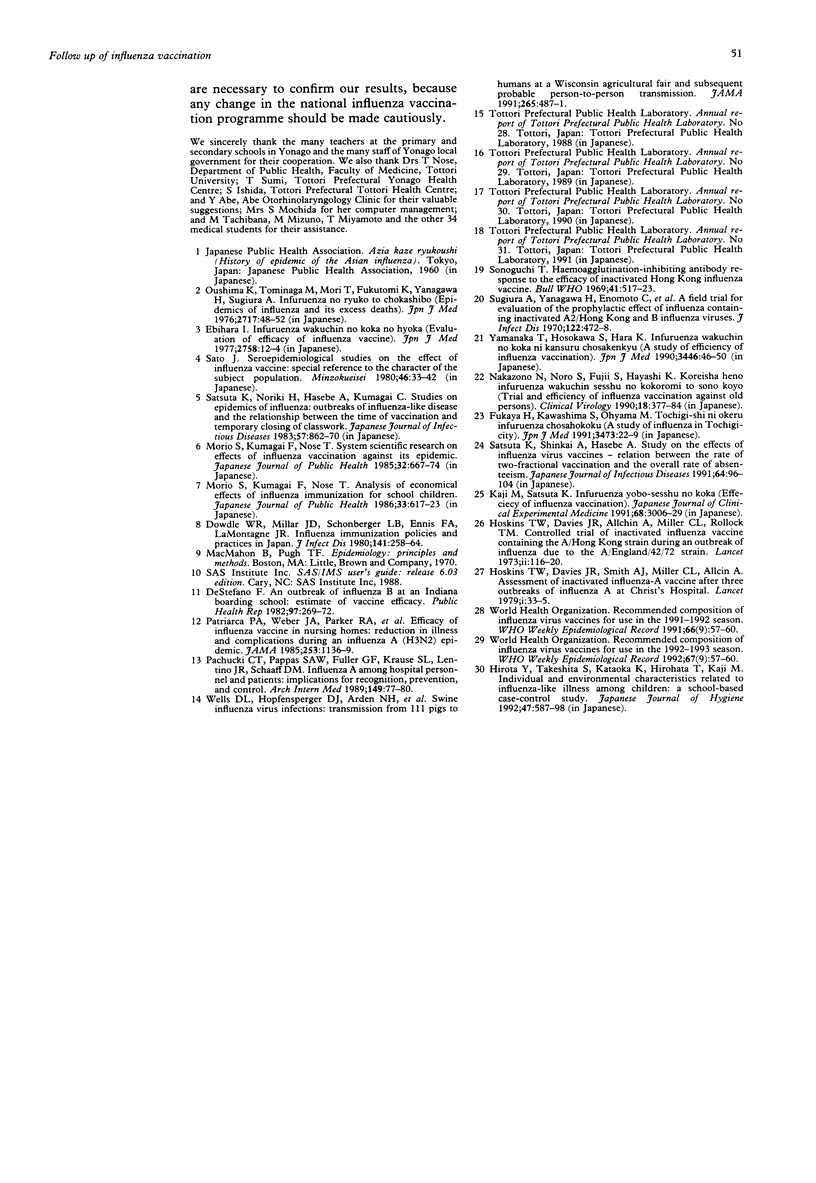
Selected References
These references are in PubMed. This may not be the complete list of references from this article.
- Asscher A. W., McLachlan M. S., Jones R. V., Meller S., Sussman M., Harrison S., Johnston H. H., Sleight G., Fletcher E. W. Screening for asymptomatic urinary-tract infection in schoolgirls. A two-centre feasibility study. Lancet. 1973 Jul 7;2(7819):1–4. doi: 10.1016/s0140-6736(73)91943-0. [DOI] [PubMed] [Google Scholar]
- DeStefano F. An outbreak of influenza B at an Indiana boarding school: estimate of vaccine efficacy. Public Health Rep. 1982 May-Jun;97(3):269–272. [PMC free article] [PubMed] [Google Scholar]
- Dowdle W. R., Millar J. D., Schonberger L. B., Ennis F. A., LaMontagne J. R. Influenza immunization policies and practices in Japan. J Infect Dis. 1980 Feb;141(2):258–264. doi: 10.1093/infdis/141.2.258. [DOI] [PubMed] [Google Scholar]
- Hirota Y., Takeshita S., Kataoka K., Hirohata T., Kaji M. Individual and environmental characteristics related to influenza-like illness among children: a school-based case-control study. Nihon Eiseigaku Zasshi. 1992 Jun;47(2):587–599. doi: 10.1265/jjh.47.587. [DOI] [PubMed] [Google Scholar]
- Hoskins T. W., Davies J. R., Smith A. J., Miller C. L., Allchin A. Assessment of inactivated influenza-A vaccine after three outbreaks of influenza A at Christ's Hospital. Lancet. 1979 Jan 6;1(8106):33–35. doi: 10.1016/s0140-6736(79)90468-9. [DOI] [PubMed] [Google Scholar]
- Pachucki C. T., Pappas S. A., Fuller G. F., Krause S. L., Lentino J. R., Schaaff D. M. Influenza A among hospital personnel and patients. Implications for recognition, prevention, and control. Arch Intern Med. 1989 Jan;149(1):77–80. [PubMed] [Google Scholar]
- Patriarca P. A., Weber J. A., Parker R. A., Hall W. N., Kendal A. P., Bregman D. J., Schonberger L. B. Efficacy of influenza vaccine in nursing homes. Reduction in illness and complications during an influenza A (H3N2) epidemic. JAMA. 1985 Feb 22;253(8):1136–1139. [PubMed] [Google Scholar]
- Satsuta K., Noriki H., Hasebe A., Kumagai C. [Studies on epidemics of influenza. Outbreaks of influenza-like disease, time of vaccination and temporary closing of schools]. Kansenshogaku Zasshi. 1983 Oct;57(10):862–870. doi: 10.11150/kansenshogakuzasshi1970.57.862. [DOI] [PubMed] [Google Scholar]
- Satsuta K., Shinkai A., Hasebe A. [Study on the effects of influenza virus vaccines--relation between the rate of two-fractional vaccination and the overall rate of absenteeism]. Kansenshogaku Zasshi. 1990 Jan;64(1):96–104. doi: 10.11150/kansenshogakuzasshi1970.64.96. [DOI] [PubMed] [Google Scholar]
- Sonoguchi T. Haemagglutination-inhibiting antibody response to and efficacy of inactivated Hong Kong influenza vaccine. Bull World Health Organ. 1969;41(3):517–523. [PMC free article] [PubMed] [Google Scholar]
- Sugiura A., Yanagawa H., Enomoto C., Ueda M., Tobita K. A field trial for evaluation of the prophylactic effect of influenza vaccine containing inactivated A2-Hong Kong and B influenza viruses. J Infect Dis. 1970 Dec;122(6):472–478. doi: 10.1093/infdis/122.6.472. [DOI] [PubMed] [Google Scholar]


